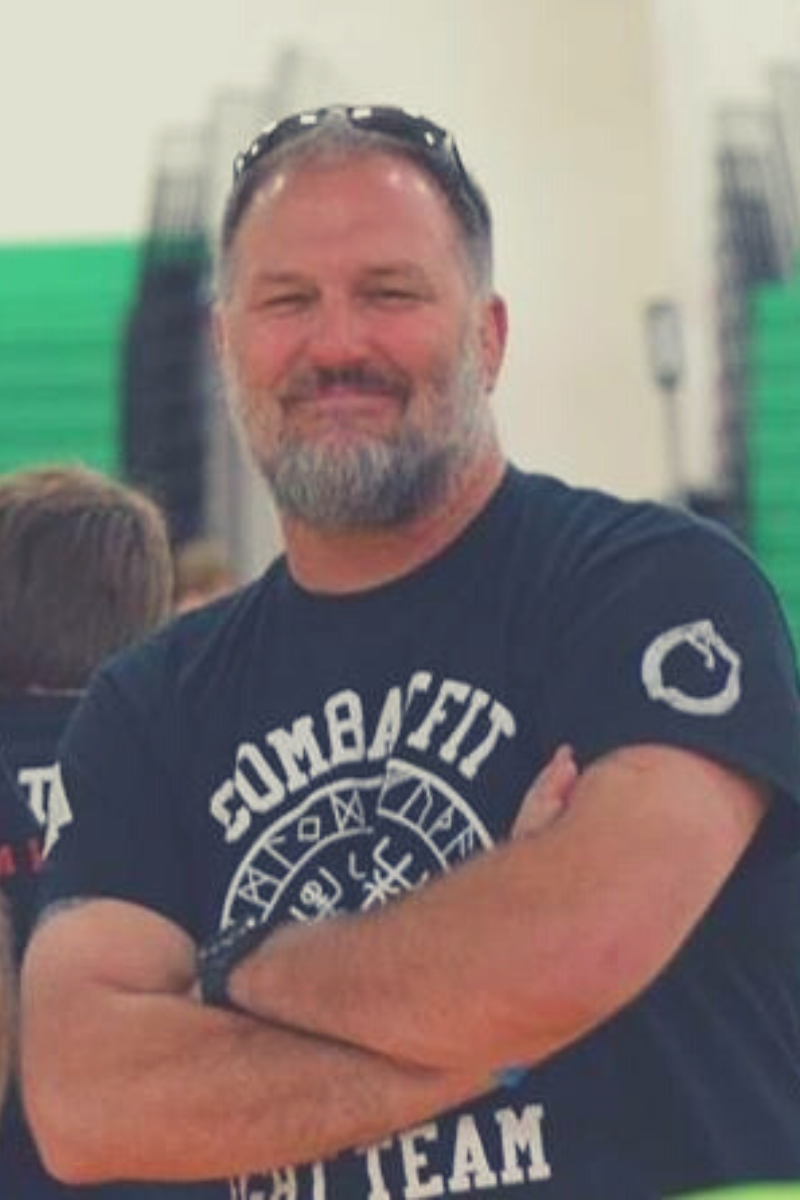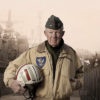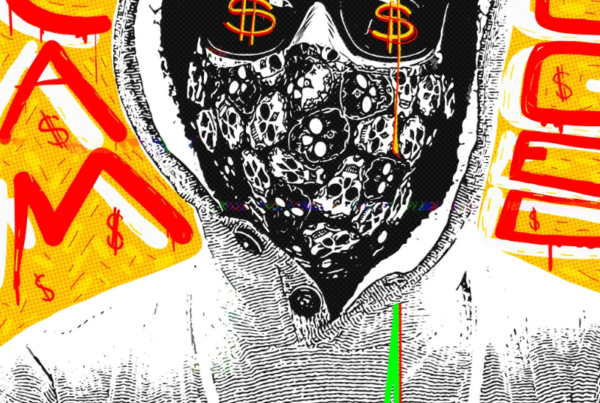Matt Larsen is the kind of person you wouldn’t want to cross while up to no good: calm, methodical, and could probably split an adversary in two with his bare hands. He has long been dubbed the “Father of Modern Combatives,” distinguished as bringing to life the U.S. Army’s modern combatives precept and establishing the Army Combatives School. He serves as the reigning Director of Combatives at West Point. (Matt also authored their modern hand-to-hand combat manual).
But there is more to his method than what meets the eye. With a background in evolutionary psychology, along with more than two decades under his belt as a U.S. Marine and later a U.S. 75th Regiment Army Ranger and private security contractor, Matt is intent on revolutionizing the way we train our military.
“Being a good fighter frees people up to not have to shoot. It gives us the ability to have a much more nuanced force, and that is what we are trying to do in a country like ours,” he tells me. “We want to be a compassionate force. We are not trying to be the bad guys; we are trying to be the guys with a much more nuanced way of utilizing their force, which is an important thing.”
His teachings hail from a multi-faceted string of disciplines and lived experiences, born out of time spent as an infantryman in the Marines stationed in Japan in 1984.
“The interesting thing was, I paid for karate whereas the judo was free, so I spent most of my time doing karate. In retrospect, it was the opposite of what I should have done,” Matt notes. “It wasn’t a waste of time, but it was less productive training.”

With that came stints of Muay Thai in Thailand, boxing, bare-knuckle battles, Brazilian Jiu-jitsu, fights everywhere from the Philippines to Korea, as well as studies of everything from UFC with the legendary Royce Gracie to Olympic wrestling with J Robinson, a former U.S. Army Ranger wrestler who competed in the 1972 Summer Olympics and went on to be the head coach at the University of Minnesota.
“The main piece of advice he told us was to be competitive not because you have people competing, but because you motivate people to excellence. If you don’t have people competing, you have hobbyists,” Matt recalls. “So that was how we developed (a program) within the Army.”
But that would take a little maneuvering. Matt’s battalion commander was General Stanley McChrystal, who urged the soldiers to pursue combat training.
“At that time, the combat training was really basic. It was basically a manual with no instructors. It was mostly centered on civilian martial arts moves, legacy stuff from World War Two and just a waste of time,” Matt remembers. “So, he (McChrystal) said, well, figure out a better way. So, I started training my guys, and then the Battalion. And then I was brought down to Fort Benning after (McChrystal) took over the whole Ranger Regiment.”
Demand for such skills quickly soared across the Army. Eventually, it led to the official “United States Army Combatives School” – a curriculum Matt has been shaping and expanding upon for over two decades. As a result, combatives are taught to every cadet who passes through West Point’s hallowed halls.
Matt sees the hybrid training as a critical middle ground between being deadly proficient in firearms and hand-to-hand combat, considering the reality that vast portions of casualties in the war theater happen within a five to six-foot radius.
Outside of his West Point duties, Matt expands upon these tenants in a consulting capacity, training everyone from law enforcement and friendly foreign forces to members of various military branches and curious civilians. He is also developing a unique and holistic BELT System, bringing together an array of tactics for holistic readiness.
What happens when an attacker reaches for their gun or knife – or your gun or knife? How does one defend and offend at the same time? How much strength and mobility are required in the heat of the moment?
It is the stuff we all should know. Matt views training as an ever-evolving process rooted in the foundation of a warrior ethos, ductility, and the capacity to be just as mentally on-point as you are physically. Often framed under the guise of “positive psychology,” this push toward resiliency has three major components.
“The first (part of this) is focused on seizing the moment, which is nothing more than the old advice to stop and smell the roses, notice if it is a beautiful sunset, or pour your significant other a great glass of wine. The second way is the flow state,” Matt explains. “The flow state is when you are doing something that you are completely enraptured by – it could be anything from skydiving to painting or the art you are producing. You are going to be so into it that you aren’t worrying about your bills; you are caught in the flow of this moment.”
That often happens during a martial arts-type fight, from grappling to boxing, as it sucks in all your focus and attention. It’s something of a return to the animal state, to a species that exists right here right now without the anxieties and woes that often plague us as humans.
Yet the problematic issue, Matt notes, is that both techniques are ephemeral.
“You have to savor the moment, you have this wonderful dinner with a loved one, or you are at Niagara Falls. But the minute you leave it, you are back in your old life. Your bills are still due, or your health problems are still there,” he continues. “Worse, it is also why people drink heavily or do drugs. You get the same flow state, temporary relief from anxiety.”
The third tenant is developing a meaningful life, a bigger purpose that can carry us through our hardships.
This is where combating veteran suicide could potentially come into play. Matt underscores that most suicides are not related to combat. (An historical examination of military records published by the JAMA Network in 2019 echoes this sentiment.)
Matt underscores the notion that joining the Armed Services gives an individual a sense of purpose, moral duty, community, and expertise. This is suddenly stripped away when that person exits their call to duty, and where combat training can potentially fill an important void.
“The warrior ethos is something that can keep people motivated to keep training, to be of use in civilian life should the occasion arise,” he surmises.
Perhaps that comes in the form of protecting an innocent bystander attacked on the street or shielding your own loved ones from harm.
Going one step further, Matt’s research and real-life application has led him to believe that so much we are taught about post-traumatic stress disorder (PTSD) is blatantly wrong. In summary, Matt’s working theory, from an evolutionary perspective, stems from the notion that “predator-prey” violence is ingrained in all species.
“The reason we have nervous systems is because of predator-prey. Violence, the very first bacteria, evolved to eat other bacteria. When it did, the bacteria eaten would (excrete) body juices. As a defensive mechanism, other bacteria learned to perceive (the juices) and then move away,” he says. “So that is the beginning of the chain that eventually gave us a way for our nerve cells to communicate with each other through chemicals. And that shows us just how deeply ingrained violence is into every species.”
Matt instructs me to close my eyes and imagine myself as a gazelle lurking through the savanna – smelling the scent of a lion lurking closer and closer.
“What do we do? Well, we will take defensive measures like maybe we move out into the open, so we can’t be ambushed. What is going on there is brain activity in your prefrontal cortex. In other words, you’re trying to outsmart the predators’ prey. It is the same with humans,” Matt conjectures. “So now, imagine that the lion jumps instead out of the weeds and is ambushing us. That’s called a circa strike. What happens in the brain of the prey animal is that the brain activity leaves the prefrontal cortex and goes back down into the mid-dorsal and midbrain areas and decoupled from the forebrain where our intelligence is located. That is what we call panic; it means you are not in control. Your root brain is taking charge.”
Continuing, Matt goes into even greater detail. Visualize the difference in the brain activity of the prey animal and the predator. The lion in this fight is just going to the grocery store; he is hungry and gets up to go to the refrigerator. His brain activity remains in the prefrontal cortex throughout the engagement because it’s not acute to him. He’s hungry, and if it doesn’t go his way, he will let go.
“So, you can make a biological taxonomy of combat experiences based upon what was going on in the fight and what portions of your brain were involved during that part of the fight,” Matt says.
Then, there is a different type of violence: social violence. Take two male crickets in a jar. They’ll go through a ritual of violence. If one is significantly bigger in size, the smaller will scurry away, and the hierarchal power is established. If the crickets are roughly the same size, they will likely wrestle and see who lands on top. But if neither can secure dominance, that is when they will really fight, Matt explains.
However, he insists there is a third and often ignored type of violence inherent in our evolution.
That hails from “coalition-forming species,” such as wolf packs or chimpanzee bands. In their own hunter-gatherer tribes, hierarchical fighting sometimes turns violent. Yet, when members of one group set their sights on competing groups, it is no longer about internal bickering. It becomes war. These coalition-forming species will fight until the end, until they can feast on another’s carcass, indicating that humans have evolved from instinct to be violent, and that violence is our natural state.
Nevertheless, our culture has shifted from this primal instinct over time, making those who have had to engage in such behaviors more exposed to ethical ostracization and internal struggle.
“What we’re finding out now within a large percentage of what we used to call PTSD is actually moral injury. When you see things or take part in things that destroy deeply held beliefs, that’s what causes moral injuries,” Matt surmises. “As we’ve just discussed, war is a normal state for human beings. War exposes what the world really is, so how do we get these unrealistic beliefs due to war?”
From Matt’s purview, the process of civilization has shaped our modern belief system.
“Imagine when we invented agriculture 10,000 years ago. We were hunter-gatherers in a constant state of war before that. And once we started agriculture, we started having specialization within our society. As we started getting more and more specialized, we had more and more people who were not involved in war,” he observes. “In development psychology, there are three vectors from which we get our morals. First, your parents or grandparents, then your teachers or preacher, and the third is your peers. That is why we play sports.”
Matt refers to this as a “sophisticated dance” of competing while cooperating, which also takes us into adulthood. As societies advance, however, the number of those still fighting – adhering to our evolutionary past – continues to decline.
“Society’s morals change over time. For example, a large percentage of our population is religious, and they think their morals come from their religion,” he explains. “And they sort of do, but they also don’t, because if they did, well, the Christians from today would have the same morals as the Christians from the Crusades. Society is different.”
Thus, with fewer people compelled to the war theater and killing a less prevalent part of daily life, combined with the injection of common morals such as the horrible nature of killing injected into us as children, the sting of moral injury harms those whose vocations have sent them into that line of fire.
Arming those suffering moral trauma with such knowledge, Matt hopes, can play a pivotal role in the healing process.











